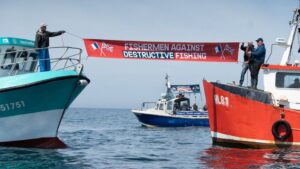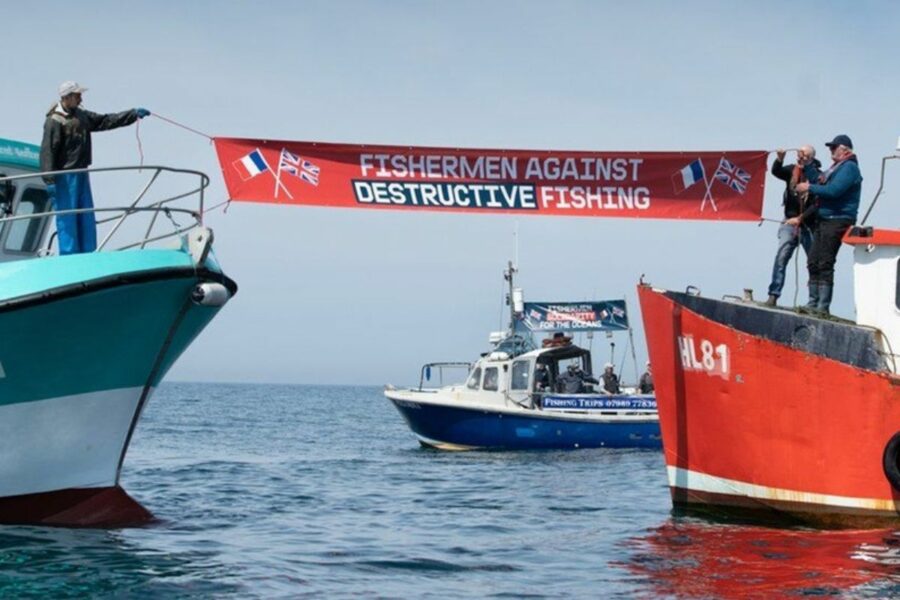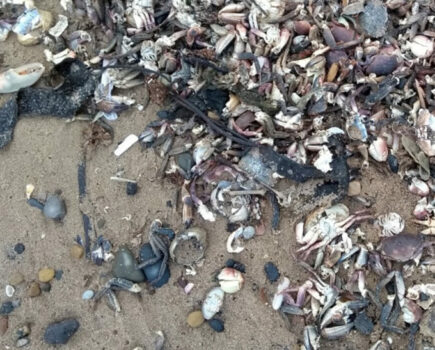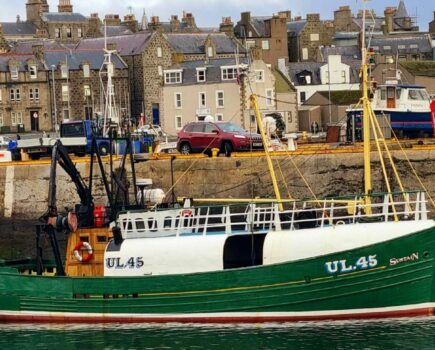Defra announced last week a widespread consultation on the management of fly-shooting in UK waters, including an online survey
The online survey is accessible here.
The fishery is operated mainly by large Anglo-Dutch vessels, targeting non-quota species including red mullet, gurnard and squid. Many of these vessels have switched in the last decade from beam trawling for plaice and sole in the southern North Sea.
The fishery has been blamed, particularly by smaller vessel operators in the English Channel, for a collapse in catch rates, putting many inshore fisheries’ livelihoods at risk. Concerned skippers partnered with Greenpeace in September 2021 when they sailed up the Thames to protest outside Westminster, and, more recently, staged a joint protest in the middle of the English Channel with French fishermen (Fishing News, 19 May, ‘English, French and greens unite in Channel protest’).
Announcing the consultation last week, fisheries minister Victoria Prentis said: “We want our fishing industry to thrive for generations to come, and we must ensure our stocks are sustainably managed.
“That’s why we are consulting on potential measures to mitigate the impacts of fly-seining on non-quota stocks. I encourage all those from the catching sector and wider fishing industry to share their views.”
The consultation will run alongside work to develop a Fisheries Management Plan (FMP) for non-quota species. The MMO has been undertaking a series of port visits across England to gather wider industry input to assist the development of the FMP – one of a number of plans in progress. Other early FMPs will cover scallops, whelk, crab and lobster.
Options touted by Defra for management of the fly-shooting fleet include:
- Introduction of an entitlement that would restrict the number of vessels permitted to use fly-seine gear
- Restricting engine power for demersal seine gears to either 221kW or 600kW in the 0-12nm zone
- Removing an exemption that currently allows a 40mm mesh size in a directed squid fishery
- Restricting vessels’ rope diameter used in fly-seine gear to 30mm or 40mm
- Restricting vessels’ rope length used in fly-seine gear to 1,500m inside 12 miles and to 3,200m outside 12 miles

Channel fisherman Martin Yorwarth, joined by NUTFA’s Jerry Percy, in a mid-Channel protest with French fishermen earlier this year, airing their concerns about the destructive impact of the large fly-shooters in the English Channel. (Photo: Suzanne Plunkett, Greenpeace)
The consultation runs until 17 November, with the expectation that the new regulations will be introduced in 2023.
Speaking to FN, Jerry Percy, the NUTFA spokesperson who has spearheaded inshore fishermen’s concerns about the impact that the large fly-shooters have had on Channel fisheries, said: “After over 18 months of discussions and pleading with Defra, we are pleased to see the publication of the consultation on fly-shooting impacts in the Channel and southern North Sea.
“We are yet to collate the comments from members and others received to date, and NUTFA will be visiting ports to more clearly identify the views of those fishermen affected by the fleet of powerful fly-shooters that have been hoovering up stocks in our inshore waters in recent years.
“Time is running out. Every day without a ban on these huge vessels continues the negative impact on stocks and the survival of our inshore fleet.
“Defra has clearly taken onboard the suggestions and recommendations put forward by NUTFA and those fishermen affected, and we welcome the opportunity to provide responses to the consultation.
“In monitoring and regulatory terms, simple is good, and a straightforward engine power limit – notwithstanding the challenges of measuring it in some cases – would appear to be the most effective way forward.
“We won the battle over pulse fishing. We really need to win the one on fly-shooting if our coastal fleet and the communities they serve are to survive and prosper.”
Newhaven-based skipper Neil Witney, who participated in the protests outside parliament and in the Channel, welcomed the Defra review, but told FN that it was way overdue.
“Restrictions on engine power, both inside and outside 12 miles, will help conservation, but a must is removal of the 40mm mesh size derogation allowed when they are squid fishing.”
Talking jointly to Fishing News, seine fisherman Brendan Leonard of the Irish-registered Caronia II W297, and Scottish seine fisherman Aaron Brown of the Acionna GK 44, currently fishing out of Cornwall, said: “We’ve been talking across the traditional seine fleet in Ireland, the UK and France, to gather a consensus between us as we react to the Defra proposals.
“French fisherman Olivier Leprêtre, who we have been in close contact with, has written to FN this week expressing similar views.
“There is grave concern across the British, French and Irish seine fleets as to the sheer size and catching power of the newly developed fly-shooters, which has stripped the English Channel of fish.
“These fly-shooters deploy twice the gross tonnage and twice the kilowatt power of the traditional British, Irish and French seine net vessels, which mirror the size and catching power of vessels developed in the 1980s and which have proved themselves as a sustainable, low-impact fishery since.
“Whereas most of these traditional seiners use 30-42mm diameter rope and lightly rigged nets to pursue the traditional form of low-impact fishery, the sheer power and hull size of these larger vessels means they are deploying 60-80mm rope and nets that are so heavily rigged that it would make many large trawlers blush.
“Defra now recognises that there needs to be an effort cap, and there seems to be a formative view by the British, Irish and French seiners that this should be a gross tonnage, kilowatt and rope diameter limit to the traditional level that has proved itself sustainable – as the French have already proposed.
“Any measures must be EEZ wide otherwise there will merely be displacement of the current problem in the Channel to other grounds. It is not where but what that is the problem.
“Defra’s suggestion of a kilowatt cap is welcome, but this seems to be only inside 12nm (why?) and at the expense of any limit of gross tonnage, which the French have long proposed in their attempts at a voluntary agreement. Defra’s approach seems strange given that engines are easy to de-rate, whilst a GT limit is much easier to enforce successfully.
“The suggestion for a rope diameter limit seems to be something that would be effective and many would support.
“What’s more concerning is the suggestion of creating a seine licence entitlement. We’ve seen before that entitlements always see some long-term participants of a fishery fall foul of a cut-off date.
“Many long-term British and Irish seine net fishermen have invested in new boats and/or amalgamated licences whilst doing so. An entitlement based on hulls or on licences could see many generational seine net men lose out. Implementation of such a measure would need to be very carefully considered.
“The major concern is that an entitlement system would merely monopolise the right to continue seining to the large vessels which have caused the problem, and now constitute one-third of the British seine net fleet.
“Whatever the precise measures to be agreed, what is certain is that the size and power of this new breed of fly-shooters is overkill, and must be limited before further fisheries worked by generational seine net families are exhausted, as we have seen happen in the Channel.
“There is a risk otherwise that environmental groups’ pressure sees all seine netting banned, because of the excesses we are seeing by one section of the fleet.”
This story was taken from the latest issue of Fishing News. For more up-to-date and in-depth reports on the UK and Irish commercial fishing sector, subscribe to Fishing News here or buy the latest single issue for just £3.30 here.








